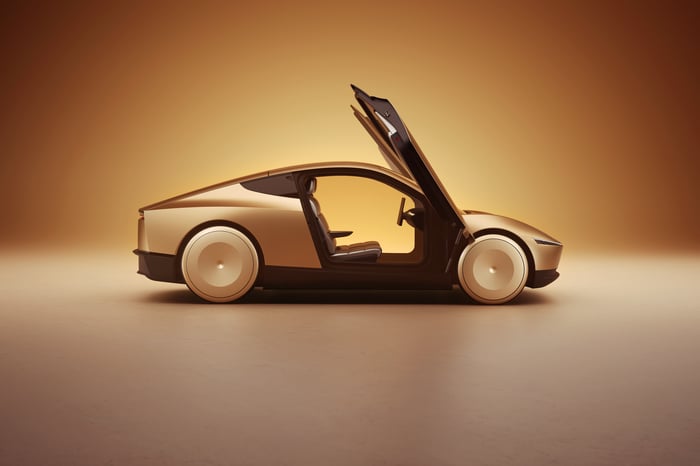|
|
|

|
|||||

|
|
Tesla recently launched its long-awaited robotaxi in June, with some caveats.
A recent survey suggests consumers are more unsure or afraid of driverless vehicles than they were a few years ago.
Tesla's future may involve more robotics, AI, and robotaxis than its traditional vehicle production.
Tesla (NASDAQ: TSLA) has already accomplished what few thought possible: It almost single-handedly advanced the world's evolution to electric vehicles (EVs). It made owning EVs cool -- even sexy -- at a time when previous EVs were inspiring very little.
Early belief in Tesla could have been described as a leap of faith. It's somewhat similar to what its investors face today: a leap of faith that the company's future will remain lucrative through its forays into artificial intelligence (AI), robotics, and, especially, robotaxis.
Where to invest $1,000 right now? Our analyst team just revealed what they believe are the 10 best stocks to buy right now. Continue »
But what if consumers don't really want driverless vehicles or robotaxis? That's what a recent survey suggests, and it's got investors rethinking their commitment to Tesla. Let me explain.

A Tesla Cybercab. Image source: Tesla.
After years of overpromising and under-delivering, Tesla finally launched a pilot program of its long-awaited robotaxi service in June. The debut, however, came with a few caveats. For instance, there was a company employee in the front passenger seat of every vehicle, and the program utilizes only 10 to 20 vehicles. Also, the rides are only open to a relatively few invitees. The reviews have been mixed, with some calling it the future and some saying vehicles had issues, including driving on the wrong side of the road.
Wedbush analyst Dan Ives had good things to say about the program. In an interview with CNBC, he said:
I thought it was extremely smooth. Everything we saw. Not just from a safety perspective. Maneuverability was way impressive. I thought actually even better than [Alphabet's] Waymo out of the gates. I thought going into it was going to be an eight out of 10. I think it's a 10 out of 10 relative to our experience.
However, a recent survey gauging driver attitudes toward self-driving vehicles appears to indicate a little pessimism about the future. The American Automobile Association (AAA) 2025 survey showed that 87% of drivers were unsure or afraid of self-driving vehicles -- the majority unsure -- while 13% trust the vehicles. That's less trusting and more afraid than the survey results from four years prior.
At least one major automaker might feel the same. Reuters is reporting that its sources say Stellantis is pausing its AutoDrive program due to high costs, technology challenges, and (as AAA's survey alluded to) consumer mistrust in self-driving vehicles.
Tesla management has made it fairly clear that the vehicle manufacturer's future is changing its focus to robotics, robotaxis, and AI. If consumers truly don't want driverless vehicles, as the survey implies, that's going to create a major headwind for its efforts. And in Tesla's defense, the survey is not the definitive answer to whether robotaxis will be successful.
People have a known propensity for being afraid of change and unsure of something groundbreaking. If you had asked me four years ago, I would have been unsure of driverless vehicles myself. People were unsure about streaming media until it became mainstream (and led to Blockbuster's demise). There was uncertainty about cars a century ago, as well as airplanes, telephones, televisions, PCs, smartphones and all sorts of other technological advances.
If there were a compelling driverless vehicle service out there, with proven safety and technology, the survey results would surely have turned out differently. It's reminiscent of the line, "If you build it, they will come." That will take time, and companies like Tesla exist to significantly change the future, even if consumers don't think they're ready for it ... yet.
So, is this latest survey a little concerning for the company's investors? Maybe. But I wouldn't raise any red flags about Tesla's robotaxi ambition because people are hesitant in 2025.
However, the road to widespread adoption of driverless vehicles will be filled with speed bumps. And investors will have to take a long look at their Tesla investing thesis because betting on its robotic, AI, and robotaxi future sure seems riskier than when it was focused on producing some of the world's best EVs.
Ever feel like you missed the boat in buying the most successful stocks? Then you’ll want to hear this.
On rare occasions, our expert team of analysts issues a “Double Down” stock recommendation for companies that they think are about to pop. If you’re worried you’ve already missed your chance to invest, now is the best time to buy before it’s too late. And the numbers speak for themselves:
Right now, we’re issuing “Double Down” alerts for three incredible companies, available when you join Stock Advisor, and there may not be another chance like this anytime soon.
*Stock Advisor returns as of August 25, 2025
Daniel Miller has no position in any of the stocks mentioned. The Motley Fool has positions in and recommends Alphabet and Tesla. The Motley Fool recommends Stellantis. The Motley Fool has a disclosure policy.
| 13 min | |
| 20 min | |
| 2 hours | |
| 4 hours | |
| 4 hours | |
| 5 hours | |
| 6 hours | |
| 6 hours | |
| 7 hours | |
| 7 hours | |
| 8 hours | |
| 9 hours | |
| 9 hours | |
| 9 hours | |
| 9 hours |
Join thousands of traders who make more informed decisions with our premium features. Real-time quotes, advanced visualizations, backtesting, and much more.
Learn more about FINVIZ*Elite